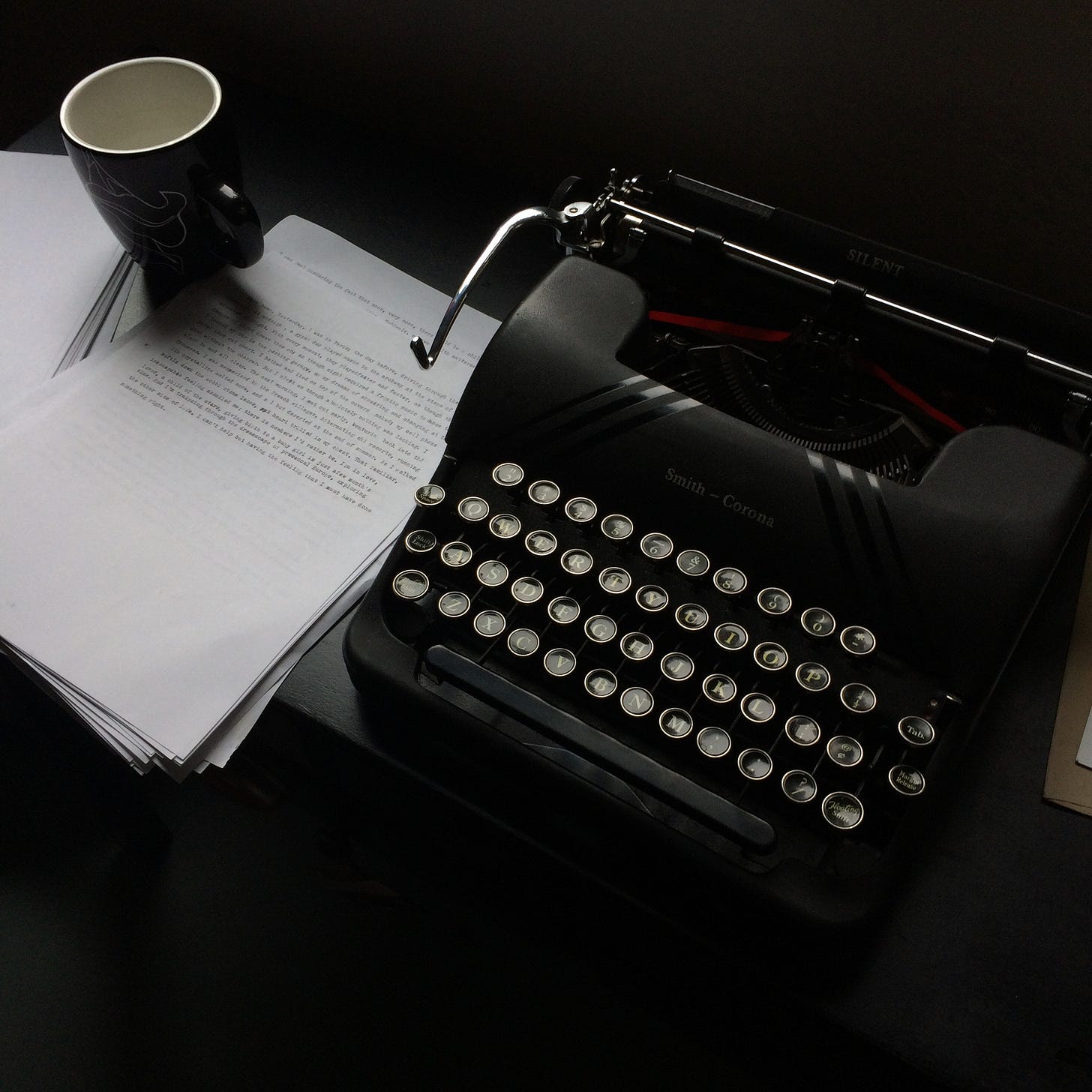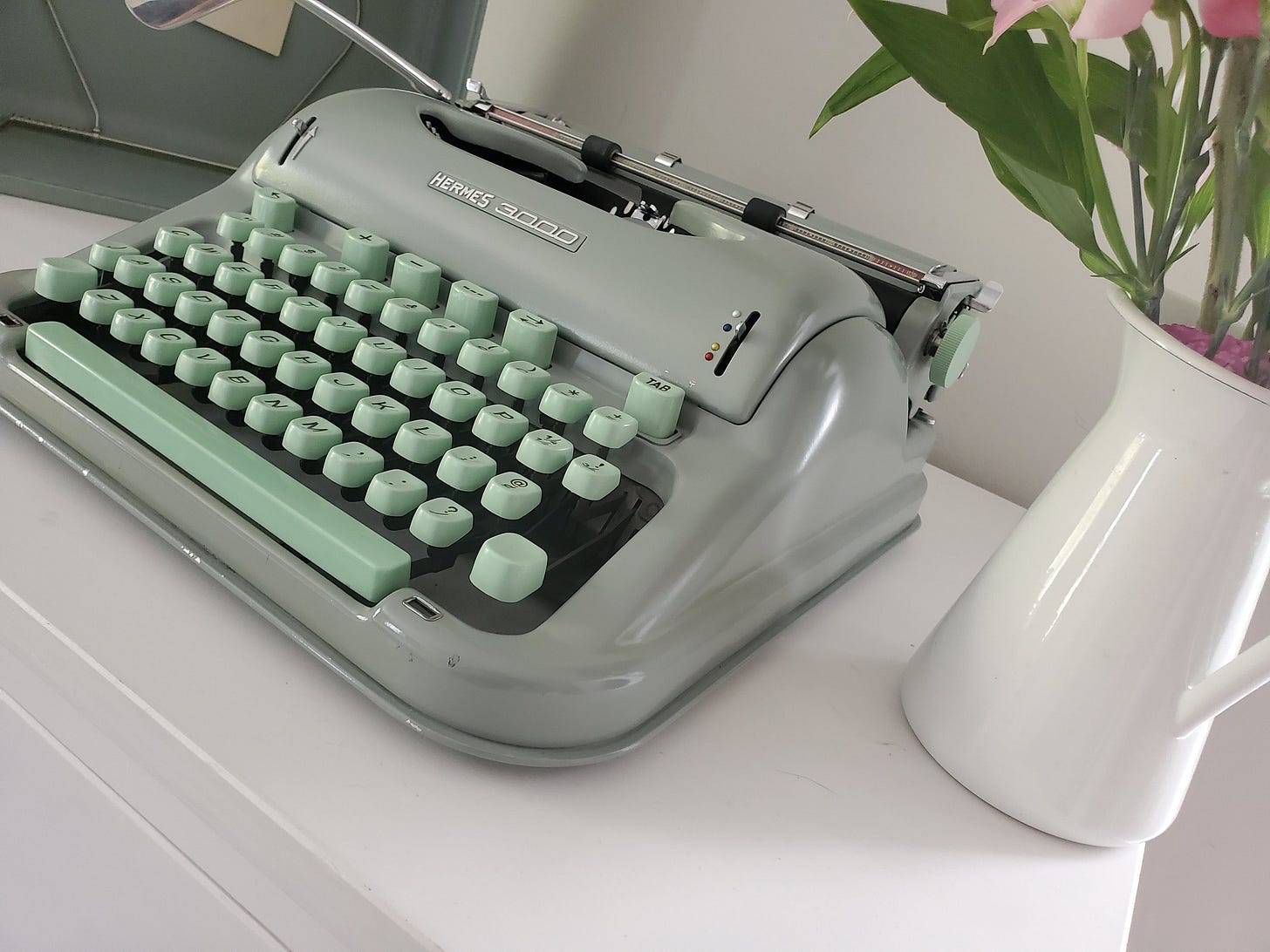The other night, someone asked me what I did. I said: I rescue writing machines from cultural oblivion. He smirked uneasily and ran away. ‘Non writer’, I thought.
So that’s our Mission Statement now:
We pull machines out of the ashes of former civilizations, and prop them in front of human hungry for inspiration.
There are all sorts of old oddities lying in dustbins and thrift stores: polaroids, wind-up film cameras, a variety of clocks, old tube amplifiers, record players, old radios, etc.
I look at those with bemused interest, but I go for the other thing:
The typewriter. Most treasured of all archaic machines in the human arsenal, at least to a novelist who is well-versed in 20th century fiction. (That's me, is it you?)
When I first got the notion to find a typewriter, it was 'out of the blue'. Lightning struck me. It was from the outer realms. Star guide, blazing notions. It came down upon me like a 20 pound hammer, though I wasn't harmed. The old me was knocked out. I was born.
Anyway, I just started to look around without a clue as to what I was looking for. And somehow the Smith Corona Silent struck me as 'cool.' I liked the jet black frame, and even the world 'Silent' glazed across the paper tray, which I had no idea how to name.
Here it is ‘in the wild (with a partial page from a novel):
By the way, some of these writings are published under a closely-guarded pseudonym. (a benefit of a vintage typewriter) though I also use many other features, like encrypted email and messaging apps, Tor browser, VPN, etc. Untraceable. I like that so that I can write freely without fear of offending anyone (or my daughters finding the writings later).
I was working with another vintage artifact of the time (in 2002), a 16mm Bolex film Camera, Swiss made like the legendary Hermes 3000 typewriter: even made by the same brand in Switzerland, Paillard. The camera fascinated me because it still worked, via a wind-up mechanism. The typewriters fascinated me for the same reason.
So what I did was, I made some stop motion Still Lifes of the typewriter rotating around. They were in stark self-developed black and white (long since destroyed or lost). I also typed some captions, and sometimes zoomed into some poetry fragments. Surreal, non-linear. I was a SFAI for a master's degree in fine art at the time, so, ya know. There were some minimalist filmmakers I was looking at.
This panned out, more or less, because that became my favorite typewriter ever. It was one of those things were, for years, I never even thought about acquiring another one. I just had reached the perfect pinnacle writing state.
First, though, I doubted myself. Was it too antique, I wondered? After all, I hadn't used any others.
I bought an SM9 from online somewhere, and though it was 'more modern', by about 20 years, it didn't really do much for me. It looked like an office machine. I mean, a tad 'utilitarian' for my tastes.
I needed something refined, ancient-looking, damn-near impractical.
So then I went further down that scale. What if it was an older machine, even less practical? Would that inspire a different form of writing? So I toyed with a Corona Four, a Corona Three, a few Underwoods, a Hammond Folding Multiplex.
What I like to do these days is work on a project on each machine, and kind of let the machine influence the voice of the project. It is more of a stylistically coherent idea, whereas what I used to do is cobble every sort of input together into the computer, just desperate for length.
Now, either way can work. When you want to write, just write.
The older machines were a little too tortuous for long-form writing, in my opinion. I wrote for a year or so on the legendary Groma Kolibri, just because I appreciated the portability, and it was reliable, pared down (no tabs or color selector), and gorgeous as a sleek racehorse. I've heard Will Self say that his Groma Kolibri was the most beautiful he'd ever seen, aside from his daughter. I'm sure many writers can relate.
So for years, I tinkered with machines out of necessity. I was like, oh shit, this weird string fell out. How do I get it back in? Or... oh no, this is not advancing the line. And every time I wanted to try a new typewriter (seeing as I was broke and could only afford dirt-cheap machines), there was some new thing to fix and learn.
Difficult cases I brought to my technician, who would show me what I was missing. Micro-escapement adjustments or bearings falling out of the carriage, etc. He was a factory trained Smith Corona Tech, knew many of the more 'esoteric' tricks of the trade, and works with us regularly now on many machines.
During Covid, many people got burned out on screens, and my in person healing and consulting work was no longer feasible, so I just started moving more machines through the shop.
Now, this was difficult for me, because I am a minimalist. I’ve always striven to own nearly nothing. I remember the gold old days of having one machine, and it was propped atop a massive Oxford English Dictionary. Now I have 100 machines in 'inventory' in a storage, and a small office where I work out the kinks of machines in the queue.
Fraught with peril.
Now, if you want a machine just to look at, you can get that in any number of places. If you want to write, it is a whole different beast. In fact, writing and having many machines around may have you running against your own aims.
Many people give up on typewriters because they try to write on a non-serviced one. Self flagellation is a similar experience.
If you do want to gather a stable, I’d suggest 3-5 max if you want to keep them all working. The reason being is because they suffer by sitting too long, and also the ribbons dry out, and they'll need occasional oiling.
What you want to do, I think, is minimize the time spent 'maintaining machines' and put as much of that time as you can into writing, editing, formatting, whatever.
Now of course, some people collect typewriters and plunk out a note every few months, and that is a valid approach as well.
To flow.
The most precious time a writer spends is drafting. That's when the genius flows in. For me, it is a time of unspeakable joy. I also love editing, though I know some writers hate it. I love to come in and see if I can be objective, and to feel the emotions that the reader might feel. And to just tweak language, as dedicated a prose stylist. Sometimes to couch difficult sentences in 'code', and release muddled sentences from semantic circles. Etc.
So, the most most beautiful thing one can do as a writer is to have one machine that is immaculately maintained, and to write daily.
And then to have a backup or two: perhaps an ultra portable for travel (though I brought my Silent damn-near everywhere), and maybe a desktop propped at a chosen location (I have a massive IBM Selectric III on my patio right now, and though it is covered, I see it gathering pollen here in North Carolina).
You might also have a few 'ancient' machines adorning the shelves. A Hammond or a Blickensderfer is a good choice for that. Or an old Franklin.
Most of the machines I sell at The Classic Typewriter Company are these 'working' machines. I mean, a few are collective rarities (like an Imperial B we recently sold, a Lavender Corona Four, a Hammond No. 12). Our sweet spot is getting you this choice and blessed writing machine so that you can write.
And I confess I keep my operation somewhat minimal so that I can write. I need to strike this balance to keep the work thrilling and inspiring.
So, write on my friend.
Steven Budden Jr.
Classic Typewriter Co.
PS. Join our Page Per Day Challenge to launch your writing ritual.








Love the shot of the Smith Corona!